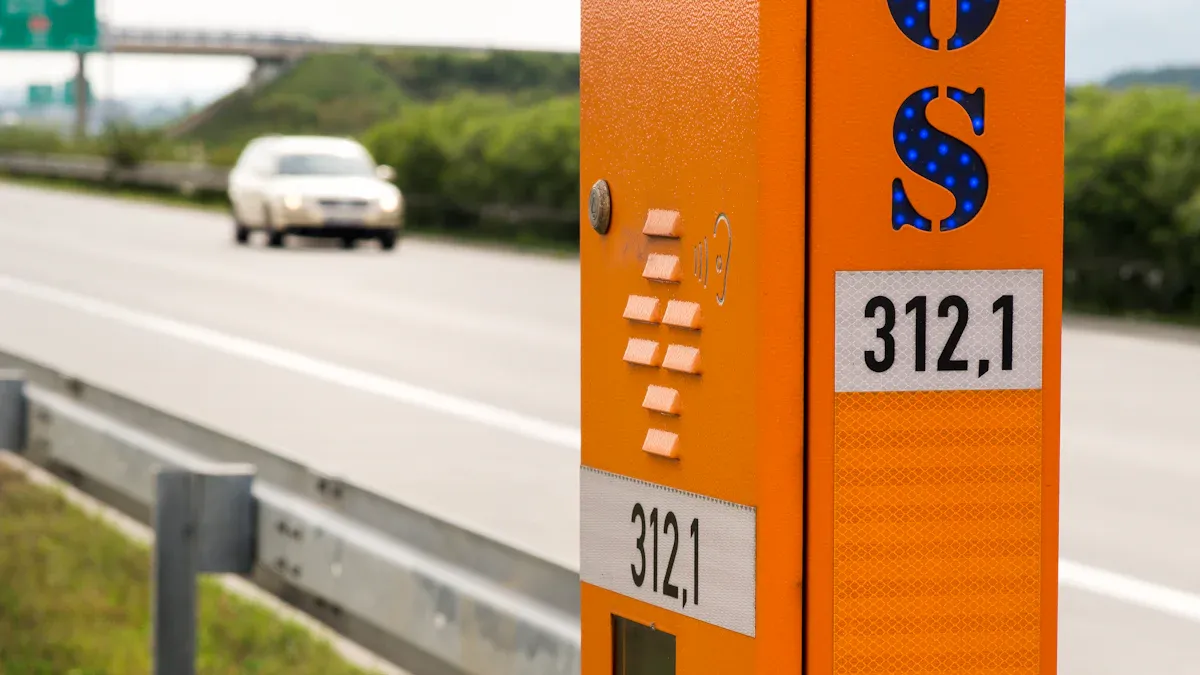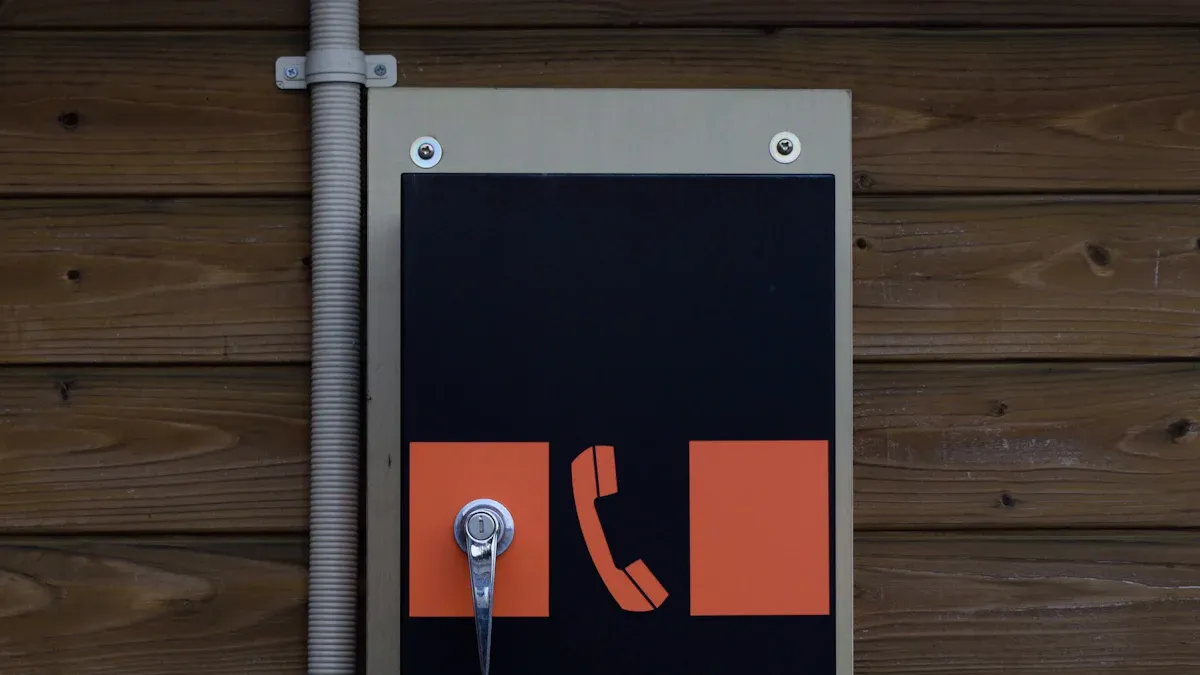
Emergencies can strike anywhere, and quick access to help saves lives. Auto dial emergency telephones bridge the gap between distress and response. These rugged emergency telephones, often found in public outdoor telephone installations, ensure immediate contact with services. Studies show ambulance response times dropped by 25 seconds after automated systems improved location accuracy, particularly in areas equipped with industrial heavy duty telephones designed for harsh environments.
Understanding Auto-Dial Emergency Telephones

What is an auto dial emergency telephone?
An auto dial emergency telephone is a specialized device designed to provide instant communication during emergencies. Unlike regular phones, it connects users directly to pre-programmed emergency numbers with the press of a button. These phones are often installed in public spaces like highways, parks, and campuses, where quick access to help is crucial. Their robust design ensures they can withstand harsh weather conditions and heavy use, making them reliable tools for public safety.
These telephones are not just for emergencies involving accidents or crimes. They also serve as lifelines for individuals who may feel unsafe or need assistance in unfamiliar areas. By eliminating the need to dial a number manually, they save precious seconds when every moment counts.
How do auto-dial emergency telephones function?
The operation of an auto dial emergency telephone is straightforward yet highly efficient. When someone presses the panic button, the system immediately dials the first programmed emergency number. It then waits for a response. If a person answers and presses a key to confirm, the speakerphone activates, allowing a two-way conversation. If no key is pressed, the system hangs up and automatically calls the next number in the sequence. This process continues until someone answers.
This sequence ensures that help is always reachable, even if the first contact is unavailable. The simplicity of the system makes it user-friendly, even for those who may not be familiar with technology. Its automated nature also reduces the chances of human error, ensuring that emergencies are handled promptly.
Key features that enhance their reliability
Auto dial emergency telephones come equipped with several features that make them dependable in critical situations. Here are some of the key attributes:
- Durable Construction: These phones are built to endure extreme weather conditions, vandalism, and heavy usage. Many models are made from industrial-grade materials to ensure longevity.
- Automated Dialing: The pre-programmed dialing system eliminates the need for manual input, reducing response times significantly.
- Backup Power Supply: Most units include backup batteries or alternative power sources to function during power outages.
- Clear Audio Quality: High-quality microphones and speakers ensure clear communication, even in noisy environments.
- Location Identification: Some models are integrated with GPS or other location-tracking technologies, helping emergency responders locate the caller quickly.
These features make auto dial emergency telephones a reliable choice for public safety. Their ability to function in challenging environments and their user-friendly design ensure they remain effective tools for emergency communication.
Benefits of Auto-Dial Emergency Telephones
Faster response times in emergencies
Emergencies demand quick action. Auto dial emergency telephones play a crucial role in reducing response times. When someone presses the button, the system immediately connects them to emergency services. This direct connection eliminates the need to search for a phone number or explain the location. Every second counts during a crisis, and these phones ensure help arrives faster.
For example, in areas like highways or parks, where accidents or medical emergencies can occur, these phones provide a reliable way to call for assistance. Emergency responders can locate the caller quickly, especially if the phone includes GPS technology. This speed can make a life-saving difference.
Accessibility for vulnerable populations
Auto dial emergency telephones are designed to be user-friendly, making them accessible to everyone, including vulnerable populations. People with disabilities, the elderly, or those unfamiliar with smartphones can easily use these phones. A single button press is all it takes to get help.
Some systems, like the Smart911 platform, enhance accessibility further. They allow users to register important information, such as medical conditions or disabilities, which is displayed to emergency responders when a call is made. Here’s a closer look at how this works:
| Feature | Description |
|---|---|
| Smart911 Platform | Allows users to enter critical information for emergency responders. |
| Vulnerable Needs Registry | Users can submit medical conditions, medications, and disabilities. |
| Information Display | Vital information is shown to call-takers when an enrolled household dials 911. |
| Participating Locations | Includes cities like Atlanta, Chicago, and Washington, DC. |
| Claims | Smart911 claims to reduce response times and save lives, though no studies confirm this. |
This kind of integration ensures that emergency services are better prepared to assist those in need. It also provides peace of mind to individuals who might otherwise hesitate to seek help.
Reliability in areas with limited connectivity
In remote or rural areas, reliable communication can be a challenge. Auto dial emergency telephones address this issue by offering dependable connections even in places with limited cell service. These phones often use landlines or satellite technology, ensuring they work when mobile networks fail.
For instance, highways in remote regions often have these phones installed at regular intervals. Travelers can use them to report accidents, breakdowns, or other emergencies. Their durable construction and backup power supplies mean they remain operational during storms or power outages. This reliability makes them an essential safety feature in areas where other communication methods might not work.
Real-World Impact of Auto-Dial Emergency Telephones

Case studies of successful emergency interventions
Auto-dial emergency telephones have proven their worth in countless real-world scenarios. One notable example comes from a highway in Southern California, where a stranded motorist used an emergency telephone to report a medical emergency. The call triggered an immediate response, and paramedics arrived within minutes, saving the individual’s life. Similarly, on a university campus, a student in distress used an emergency phone to contact campus security. The quick intervention prevented a potentially dangerous situation. These cases highlight how these phones act as lifelines during critical moments, ensuring help is always within reach.
Examples from public spaces like highways and campuses
Public spaces benefit immensely from the presence of auto-dial emergency telephones. Highways, in particular, have long relied on these devices to enhance safety. In the UK, emergency telephones are installed every 1.6 kilometers on motorways and major roads, providing drivers with a reliable way to call for help. Southern California took it a step further, placing emergency phones every 0.25 miles on limited-access highways since the 1970s. Although the usage of freeway call boxes in California dropped from 98,000 calls in 2001 to 20,100 in 2010, their presence remains vital for those without access to mobile phones. On university campuses, these phones connect directly to campus security, offering students and staff a quick way to report emergencies or suspicious activity.
Stories of lives saved through quick access
The ability to access help quickly can mean the difference between life and death. One story involves a motorist who used an auto dial emergency telephone during a severe snowstorm. The call allowed rescue teams to locate the stranded vehicle and save the occupants before conditions worsened. Another account comes from a park where a hiker used an emergency phone to report a heart attack. The rapid response ensured the individual received medical attention in time. These stories underscore the importance of having reliable emergency communication systems in place, especially in areas where other options might fail.
Addressing Concerns About Auto-Dial Emergency Telephones
Cost and funding considerations
Installing auto dial emergency telephones might seem expensive at first glance, but the benefits far outweigh the costs. Communities often worry about funding these systems, especially in areas with tight budgets. However, many governments and organizations offer grants or subsidies for public safety initiatives. Local businesses sometimes pitch in, recognizing the value these phones bring to their customers and employees.
Breaking down the expenses can help. Initial costs include purchasing the phones and setting up the infrastructure. After that, maintenance and occasional upgrades are the main expenses. Communities can save money by choosing durable models that require less frequent repairs. Plus, the peace of mind these phones provide is priceless.
Maintenance and long-term reliability
Keeping auto dial emergency telephones in good shape is crucial. Regular maintenance ensures they work when needed most. Many models are built to last, with features like weatherproofing and vandal-resistant designs. Even so, routine checks help spot issues early.
Communities can set up maintenance schedules to inspect the phones every few months. Some systems even include self-diagnostic tools that alert technicians to problems. This proactive approach keeps costs low and reliability high. When emergencies happen, people need to trust that the phone will work without fail.
Why they remain essential despite widespread smartphone use
Smartphones are everywhere, but they’re not always reliable in emergencies. Batteries die, signals drop, and not everyone knows how to use them effectively. Auto dial emergency telephones fill these gaps. They’re easy to use, don’t rely on cellular networks, and are always ready to go.
Imagine being stranded on a highway with no phone signal. An auto dial emergency telephone becomes a lifeline. It’s also a safer option for vulnerable populations who might struggle with smartphones. These phones ensure that help is always accessible, no matter the situation.
Tip: Smartphones are great, but they’re not foolproof. Auto dial emergency telephones provide a dependable backup when technology fails.
Auto-dial emergency telephones aren’t just devices; they’re lifelines. Communities that install them show they care about safety and well-being. These phones save lives, reduce response times, and offer peace of mind.
Call to Action: Local governments and organizations should prioritize these systems. Investing in them creates safer spaces for everyone, from residents to visitors.
FAQ
How do auto-dial emergency telephones work during power outages?
Most models include backup batteries or alternative power sources. These ensure the phones stay operational even when the main power supply fails.
Tip: Regularly check backup systems to maintain reliability.
Are auto-dial emergency telephones easy to use for children?
Yes, they are designed for simplicity. Pressing a single button connects directly to emergency services, making them accessible for kids in distress.
Can these phones be vandalized easily?
No, they’re built with industrial-grade materials. Their vandal-resistant designs ensure durability in public spaces.
Note: Routine inspections help identify any damage early.


